
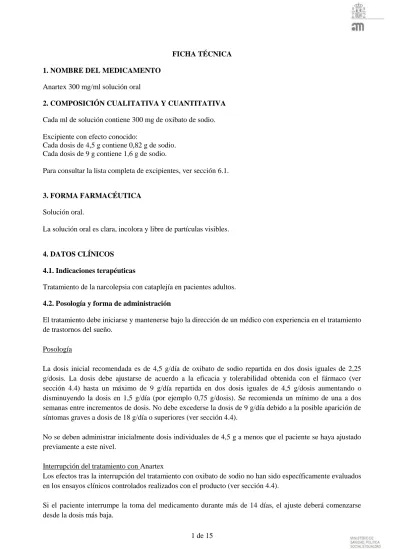
ANARTEX 300 MG/ML ORAL SOLUTION

Ask a doctor about a prescription for ANARTEX 300 MG/ML ORAL SOLUTION

How to use ANARTEX 300 MG/ML ORAL SOLUTION
Introduction
Package Leaflet: Information for the User
Anartex®300 mg/ml oral solution
Sodium oxybate
Read all of this leaflet carefully before you start taking this medicine because it contains important information for you.
- Keep this leaflet, you may need to read it again.
- If you have any further questions, ask your doctor or pharmacist.
- This medicine has been prescribed for you only. Do not pass it on to others. It may harm them, even if their signs of illness are the same as yours.
- If you get any side effects, talk to your doctor or pharmacist. This includes any possible side effects not listed in this leaflet. See section 4.
Contents of the package leaflet:
- What is Anartex and what is it used for
- What you need to know before you take Anartex
- How to take Anartex
- Possible side effects
- Storage of Anartex
- Contents of the pack and other information
1. What is Anartex and what is it used for
Anartex contains the active substance sodium oxybate. Anartex acts by consolidating nocturnal sleep, although its exact mechanism of action is not known.
Anartex is used to treat narcolepsy with cataplexy in adults, adolescents, and children from 7 years of age.
Narcolepsy is a sleep disorder that can include sleep attacks during the hours when you are normally awake, as well as cataplexy, sleep paralysis, hallucinations, and insomnia. Cataplexy is the sudden onset of weakness or muscle paralysis without loss of consciousness, in response to a sudden emotional reaction such as anger, fear, joy, laughter, or surprise.
2. What you need to know before you take Anartex
Do not takeAnartex
- if you are allergic to sodium oxybate or any of the other ingredients of this medicine (listed in section 6);
- if you have a deficiency of semialdehyde dehydrogenase (a rare metabolic disorder);
- if you suffer from severe depression;
- if you are receiving treatment with opioid or barbiturate medications.
Warnings and precautions
Consult your doctor or pharmacist before starting to take Anartex.
- if you have respiratory or pulmonary problems (and especially if you are obese), as Anartex has the potential to cause breathing difficulties;
- if you have or have had depression, suicidal thoughts, anxiety, psychosis (a mental disorder that can involve hallucinations, incoherent speech, or disorganized and agitated behavior) or bipolar disorder;
- if you suffer from heart failure, high blood pressure, liver or kidney problems, you may need to have your dose adjusted;
- if you have previously consumed drugs or abused medications;
- if you suffer from epilepsy, as the use of Anartex is not recommended in this disease;
- if you suffer from porphyria (a rare metabolic disorder).
If you suffer from any of these problems, inform your doctor before taking Anartex.
If, while taking Anartex, you experience nocturnal urinary incontinence, confusion, hallucinations, sleepwalking episodes, or abnormal thinking, you should immediately inform your doctor. Although these effects are rare, if they occur, they are usually mild to moderate in nature.
In elderly patients, the doctor will carefully monitor your progress to check if Anartex produces the desired effects.
Anartex has a well-known potential for abuse. There have been cases of dependence after illicit use of sodium oxybate.
Your doctor will ask you if you have consumed any drugs before starting to take Anartex and while you are taking this medicine.
Children and adolescents
Anartex can be taken by adolescents and children from 7 years of age who weigh more than 15 kg.
Anartex cannot be taken by children under 7 years of age or who weigh less than 15 kg.
If you are a child or adolescent, your doctor will regularly check your body weight.
While the doctor is adjusting the dose, which can take several weeks, parents/caregivers must carefully monitor the child's breathing during the first 2 hours after taking sodium oxybate to assess if there is any anomaly in breathing; for example, interruption of breathing during short periods while sleeping, noisy breathing, and a bluish color in the lips and face. If breathing anomalies are observed, medical assistance should be sought and the doctor should be informed as soon as possible. If any anomaly is observed after the first dose, the second dose should not be administered. If no anomaly is observed, the second dose can be administered. The second dose should not be administered before 2.5 hours or after 4 hours after the administration of the first dose.
If you have had or are having unpleasant sensations, especially if you feel very sad or have lost interest in life, it is important that you inform your doctor or caregiver.
UsingAnartexwith other medicines
Tell your doctor or pharmacist if you are using, have recently used, or might use any other medicines.
In particular, Anartex should not be used with medicines that induce sleep and medicines that reduce the activity of the Central Nervous System (the Central Nervous System is the part of the body composed of the brain and spinal cord):
You should also inform your doctor or pharmacist if you are using any of the following types of medicines:
- medicines that increase the activity of the central nervous system and antidepressants
- medicines that can be metabolized in a similar way by the body (e.g., valproate, phenytoin, or ethosuximide, which are used to treat epileptic seizures).
*topiramate (used to treat epilepsy)
TakingAnartexwith alcohol
Do not drink alcohol while taking Anartex, as its effects may be increased.
Pregnancy and breastfeeding
If you are pregnant or breastfeeding, think you may be pregnant, or plan to become pregnant, consult your doctor or pharmacist before using this medicine.
There have been very few women who have taken oxybate during pregnancy, and some of them suffered spontaneous abortions. The risk of taking Anartex during pregnancy is not known, so its use is not recommended in pregnant women or women trying to become pregnant.
Patients taking Anartex should stop breastfeeding, as Anartex passes into breast milk. Changes in sleep have been observed in infants of exposed mothers.
Driving and using machines
Anartex can affect you if you drive or use machines. Do not drive, do not use heavy machinery, or perform any activity that may be hazardous or require mental alertness for at least 6 hours after taking Anartex. When you first start taking Anartex and until you know if it makes you sleepy the next day, be extra careful when driving, operating heavy machinery, or doing any other activity that could be hazardous or requires complete mental alertness.
In pediatric patients, doctors, parents, or caregivers are warned that the waiting time to perform activities that require a state of mental alertness, motor coordination, or activities that may have a physical risk may be more than 6 hours, depending on individual sensitivity.
Anartexcontains sodium
This medicine contains 182.24 mg of sodium (the main component of table salt/cooking salt) per gram. This is equivalent to 9.11% of the maximum daily recommended sodium intake for an adult.
Consult your doctor or pharmacist if you need 2 grams of sodium oxybate (Anartex) or more per day for a prolonged period, especially if you have been advised to follow a low-salt (sodium) diet.
This is also relevant for children, where the maximum daily intake is considered proportional to that of adults and is based on energy needs.
3. How to take Anartex
Follow the administration instructions of this medicine exactly as indicated by your doctor or pharmacist. In case of doubt, consult your doctor or pharmacist again.
It is important that you only use the syringe and measuring cups included in the box when preparing the doses of Anartex. The Anartex syringe has two different measurement units: grams (g) and milliliters (ml).
Adults: taking Anartex alone
- For adults, the recommended initial dose is 4.5 grams per day, divided into two separate doses of 2.25 grams.
- Your doctor may gradually increase your dose up to a maximum of 9 grams per day, divided into two separate doses of 4.5 grams.
- Take Anartex orally twice each night:
- Take the first dose when going to bed and the second dose 2.5 to 4 hours later. You may need an alarm clock to make sure you wake up to take the second dose.
- Food decreases the amount of Anartex absorbed by your body. Therefore, it is best to take Anartex always at a certain time, 2-3 hours after meals.
- Prepare both doses before going to bed.
- Take the doses within 24 hours after preparation.
Adolescents and children from 7 years who weigh 15 kg or more: taking Anartex alone
For children from 7 years who weigh 15 kg or more, the doctor will calculate the suitable dose based on body weight.
The doctor will calculate the suitable dose for you. Do not exceed the dose that has been prescribed for you.
Adults: taking Anartex with valproate
If you are taking valproate with Anartex, your doctor will adjust the dose of Anartex.
- For adults, the recommended initial dose of Anartex when used with valproate is 3.6 grams per day, divided into two separate doses of 1.8 grams.
- Take the first dose when going to bed and the second dose 2.5 to 4 hours later.
Adolescents and children from 7 years who weigh 15 kg or more: taking Anartex with valproate
If you are taking valproate with Anartex, your doctor will adjust the dose of Anartex.
Kidney or liver problems
- If you have kidney problems, you should take into account the dietary recommendations to reduce sodium (salt) intake.
- If you have liver problems, the initial dose should be reduced by half. Your doctor may gradually increase your dose.
Instructions for diluting Anartex
There are other oral solutions of sodium oxybate, but each of them has a different mode of administration. Read carefully the mode of administration of this medicine and if you have doubts, ask your pharmacist.
The following instructions explain how to prepare Anartex. Read the instructions carefully and follow them step by step.
To help you, the Anartex package contains 1 bottle of medicine, a graduated syringe in grams (g) and milliliters (ml), an adapter, and two measuring cups of approximately 60 ml capacity with child-resistant safety caps.
Anartex contains 300 mg of sodium oxybate per ml of solution. A dose of 4.5 grams of sodium oxybate corresponds to 15 ml of solution. The syringe you will use to administer the medicine and which is included in the package is graduated in grams (1.5g, 2.25g, 3.0g, 3.75g, 4.5g) and in milliliters (5 ml, 7.5 ml, 10 ml, 12.5 ml, 15 ml) with horizontal marks every 0.25 grams (or 1.25 ml). The measuring cups do not have graduation marks. The following table includes the volume equivalences of Anartex solution and grams of sodium oxybate it contains. You should look at the first column of the table ("Amount in grams of Anartex") when preparing your dose with the graduated syringe in grams, as this is how your doctor will prescribe it:
Amount in grams of Anartex | Equivalent amount in ml of Anartex |
1.5 g | 5 ml |
2.25 g | 7.5 ml |
3.0 g | 10 ml |
3.75 g | 12.5 ml |
4.5 g | 15 ml |
Each measured dose of Anartex must be dispensed into the measuring cup and diluted in 60 ml of water before taking. The 60 ml are approximately the volume of the measuring cup included in the package, which corresponds to approximately 4 tablespoons.
- Remove the cap from the bottle by pressing down and unscrewing it counterclockwise (to the left). After removing the cap, place the bottle upright on a table. Keeping the bottle upright, insert the adapter into the neck of the bottle by pressing it. This should only be done the first time the bottle is opened. The adapter can be left on the bottle for subsequent uses.
- Then, insert the tip of the graduated syringe into the center of the bottle opening and press firmly (See Figure 1).
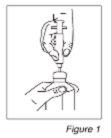
- Maintaining the bottle and syringe in one hand, prepare the prescribed dose with the other hand by pulling the plunger. NOTE: The medicine will not flow into the syringe unless you keep the bottle in an inverted position (See Figure 2).
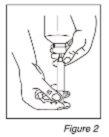
- After preparing the dose, place the bottle upright and remove the syringe from the center of the bottle opening. Empty the medicine from the syringe into one of the measuring cups provided by pushing the plunger (See Figure 3). Repeat this step for the second measuring cup. Then add approximately 60 ml of water to each measuring cup (60 ml are approximately 4 tablespoons).
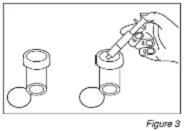
- Put the caps on the measuring cups and turn each cap clockwise (to the right) until you feel the click and close it in the child-resistant position (See Figure 4). Rinse the syringe with water.
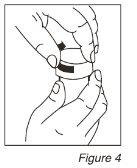
- Just before going to bed:
- Adult patients should place their second dose near their bed.
- Parents or caregivers of adolescents and children from 7 years should not leave the second dose near the child's bed or within their reach.
- You may need an alarm clock to make sure you wake up to take your second dose, no earlier than 2.5 hours and no later than 4 hours after your first dose.
Then
- Remove the cap from the first measuring cup by pressing the child-resistant safety cap and turning it counterclockwise (to the left).
- Drink the first dose sitting in bed, cover the cup, and then lie down immediately. In the case of children who sleep more than 8 hours but less than 12, the first dose can be administered after the child has slept for 1 to 2 hours.
- When you wake up or wake the child between 2.5 and 4 hours later, remove the cap from the second measuring cup. Sitting in bed, drink the second dose just before lying down again to continue sleeping. Cover the second cup.
If you think the effect of Anartex is too strong or too weak, tell your doctor or pharmacist.
If you take moreAnartexthan you should
The symptoms of an overdose of Anartex can include agitation, confusion, altered mobility, breathing difficulties, blurred vision, excessive sweating, headache, vomiting, decreased consciousness that can lead to coma, epileptic seizure, excessive thirst, muscle cramps, and weakness. If you take more Anartex than you should, or take it by accident, seek immediate emergency medical help. You should take the medicine package with you, even if it is empty.
In case of overdose or accidental ingestion, consult your doctor or pharmacist immediately or call the Toxicology Information Service, phone: 91 562 04 20, indicating the medicine and the amount ingested.
If you forget to takeAnartex
If you forget to take the first dose, take it as soon as you remember and continue with the procedure described previously. If you miss the second dose, skip that dose and do not take Anartex again until the next night. Do not take a double dose to make up for the missed doses.
If you are not sure if you have taken Anartex
In case of doubt about the administration of a dose, do not administer the dose again to reduce the risk of overdose.
If you stop treatment withAnartex
You should continue taking Anartex as long as your doctor prescribes it. If you stop the medication, cataplexy attacks may return, and you may experience insomnia, headache, anxiety, dizziness, sleep disorders, somnolence, hallucinations, and abnormal thinking.
If you stop treatment with Anartex for more than 14 days, you should consult your doctor, as you will need to start treatment with Anartex again from a lower dose.
If you have any other questions about the use of this medicine, ask your doctor or pharmacist.
4. Possible Adverse Effects
Like all medicines, this medicine can cause adverse effects, although not all people suffer from them. These are often of mild to moderate intensity.
Adults: most frequent adverse effects observed in clinical studies(occurring in 10% to 20% of patients):
- dizziness
- nausea
- headache
If you experience any of these adverse effects, inform your doctor immediately.
Children and adolescents: most frequent adverse effects observed in a clinical study:
- bedwetting (18.3%)
- nausea (12.5%)
- vomiting (8.7%)
- weight loss (8.7%)
- decreased appetite (6.7%)
- headache (5.8%)
? dizziness (5.8%)
- suicidal thoughts (1%)
- feeling mentally unwell (loss of contact with reality) (1%)
If you experience any of these adverse effects, inform your doctor immediately.
The adverse effects in adults and children are the same. If you experience any of these adverse effects, inform your doctor immediately:
Very common (may affect more than 1 in 10 people):
- nausea
- dizziness
- headache
Common (may affect up to 1 in 10 people):
- sleep problems such as insomnia, abnormal dreams, sleep paralysis, somnolence, nightmares, sleepwalking, bedwetting, excessive daytime sleepiness, difficulty falling asleep in the middle of the night
- feeling of drunkenness, tremors, confusion or disorientation, blurred vision, balance disorder, falls, feeling of "dizziness" (vertigo)
- feeling heartbeats, increased blood pressure, shortness of breath
- vomiting, stomach pain, diarrhea
- anorexia, decreased appetite, weight loss
- weakness, fatigue, sedation
- sweating
- depression
- muscle cramps, swelling
- joint pain, back pain
- attention disturbance, altered sensitivity essentially to touch, abnormal touch sensation, abnormal taste
- anxiety, nervousness
- urinary incontinence
- snoring, nasal congestion
- rash
- breast inflammation, nasal and throat inflammation
Uncommon (may affect up to 1 in 100 people):
- psychosis (a mental disorder that can include hallucinations, incoherent speech or disorganized and agitated behavior)
- paranoia, abnormal thinking, hallucinations, agitation, attempted suicide
- difficulty falling asleep, restless legs
- memory loss
- myoclonus (involuntary muscle contractions)
- involuntary bowel movements
- hypersensitivity
Frequency not known (cannot be estimated from the available data):
- seizure
- decrease in depth or frequency of breathing, short cessation of breathing during sleep
- urticaria
- suicidal thoughts, delirium, thoughts of committing violent acts (including harming others)
- irritability, aggression
- euphoric mood
- panic attack
- mania/bipolar disorder
- dry mouth, dehydration
- facial swelling (angioedema)
- bruxism (bruxism and jaw clenching)
- pollakiuria/urinary urgency (increased need to urinate)
- tinnitus (noise in the ears, such as ringing or buzzing)
- sleep-related eating disorder
- increased appetite
- loss of consciousness
- dykinesia (e.g., abnormal and uncontrolled movements of the limbs)
- dandruff
- increased sexual desire
- nocturia (excessive urination at night)
- feeling of suffocation
If you experience any of these side effects, inform your doctor immediately.
Reporting of Adverse Effects
If you experience any type of adverse effect, consult your doctor or pharmacist or nurse, even if it is a possible adverse effect that does not appear in this prospectus. You can also report them directly through the Spanish Pharmacovigilance System for Human Use Medicines: https://www.notificaram.es. By reporting adverse effects, you can contribute to providing more information on the safety of this medicine.
5. Storage of Anartex
Keep this medicine out of the sight and reach of children.
Do not use this medicine after the expiration date that appears on the bottle after (CAD). The expiration date is the last day of the month indicated.
This medicine does not require special storage conditions.
After dilution in the dosing cups, the preparation should be used within 24 hours.
Once the Anartex bottle is opened, any unused content must be discarded 40 days after opening.
Medicines should not be thrown away through the drains or into the trash. Ask your pharmacist how to dispose of the packaging and medicines that are no longer needed. This will help protect the environment.
Once finished, discard the packaging, including the syringes, adapter, and dosing cups.
6. Package Contents and Additional Information
Composition ofAnartex
- The active ingredient is sodium oxybate. Each ml contains 300 mg of sodium oxybate.
- The other components are purified water, malic acid, and sodium hydroxide.
Appearance of the Product and Package Contents
Anartex is presented in a 300 ml amber plastic bottle containing 300 ml of oral solution, closed with a child-resistant cap. Each package contains a bottle, an adapter, a graduated plastic syringe in grams (1.5g, 2.25g, 3.0g, 3.75g, 4.5g) and in milliliters (5 ml, 7.5 ml, 10 ml, 12.5 ml, 15 ml) with horizontal marks every 0.25 grams (or 1.25 ml) and two dosing cups with child-resistant caps. The dosing cups do not have graduation marks.
Anartex is a clear, colorless, and particle-free solution.
Marketing Authorization Holder
Accord Healthcare S.L.U.
World Trade Center
Moll de Barcelona, s/n.
Edifici Est 6ª planta 08039 - Barcelona
Spain
Manufacturer
Medichem S.A.
Narcís Monturiol, 41 A
08970 Sant Joan Despí
Barcelona, Spain
or
Laboratorios Salvat, S.A.
Gall, 30-36
08950 Esplugues de Llobregat (Barcelona)
Spain
Date of the Last Revision of this Prospectus: October 2021
Other Sources of Information
Detailed and updated information on this medicine is available on the website of the Spanish Agency for Medicines and Health Products (AEMPS) http://www.aemps.es/.
- Country of registration
- Active substance
- Prescription requiredYes
- Manufacturer
- This information is for reference only and does not constitute medical advice. Always consult a licensed doctor before taking any medication. Oladoctor is not responsible for medical decisions based on this content.
- Alternatives to ANARTEX 300 MG/ML ORAL SOLUTIONDosage form: ORAL SOLUTION/SUSPENSION, 500 mg/mlActive substance: sodium oxybateManufacturer: Laboratorios Normon S.A.Prescription requiredDosage form: ORAL SOLUTION/SUSPENSION, 500 mg/mlActive substance: sodium oxybateManufacturer: Zentiva K.S.Prescription requiredDosage form: ORAL SOLUTION/SUSPENSION, 500 mg/mlActive substance: sodium oxybateManufacturer: Laboratorio Reig Jofre, S.A.Prescription required
Alternatives to ANARTEX 300 MG/ML ORAL SOLUTION in other countries
The best alternatives with the same active ingredient and therapeutic effect.
Alternative to ANARTEX 300 MG/ML ORAL SOLUTION in Poland
Alternative to ANARTEX 300 MG/ML ORAL SOLUTION in Ukraine
Online doctors for ANARTEX 300 MG/ML ORAL SOLUTION
Discuss dosage, side effects, interactions, contraindications, and prescription renewal for ANARTEX 300 MG/ML ORAL SOLUTION – subject to medical assessment and local rules.












